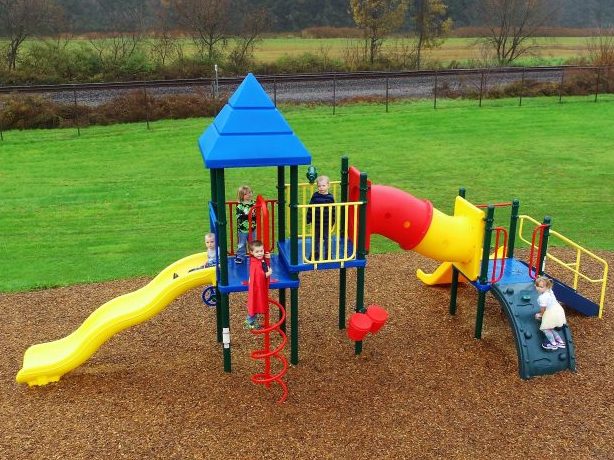
Creating a safe and engaging play environment starts from the ground up. While playground equipment often takes center stage, the surface beneath it plays a crucial role in protecting children from injuries. Whether you’re designing a schoolyard, community park, or daycare play area, choosing the right playground safety surfacing is one of the most important decisions you’ll make!
In this comprehensive guide, we’ll explore everything you need to know about playground safety surfacing, from material types and safety standards to installation tips, cost considerations, and long-term maintenance.
Why Playground Safety Surfacing Matters
When designing a playground, it’s easy to focus on the fun, colorful slides, exciting climbers, and interactive panels, but beneath all of that is the most important safety feature of the entire space: the surface. Safety surfacing is not just a finishing touch; it’s a critical component that protects children, supports accessibility, and contributes to long-term usability.
Playground safety surfacing is designed to prevent serious and debilitating head injuries. Each safety surface is “drop-tested” using a scientific device to determine whether it falls in the acceptable range for impact absorption. Only then can it become IPEMA-certified.
Injury Prevention
Falls are the leading cause of playground injuries, particularly those resulting in serious harm. From toddlers just learning to walk to school-aged children testing their physical limits, every child benefits from a surface that cushions fall and reduces impact. Proper surfacing drastically decreases the likelihood of broken bones, concussions, and other traumatic injuries. It acts as a first line of defense when accidents happen (and they will).
Compliance with Safety Standards
Playgrounds in schools, parks, and childcare centers must meet strict safety standards. Surfacing should comply with guidelines set by the Consumer Product Safety Commission (CPSC), ASTM International (particularly ASTM F1292 for impact attenuation), and the Americans with Disabilities Act (ADA) for accessibility.
For even greater assurance, look for products with IPEMA (International Play Equipment Manufacturers Association) certification. IPEMA-certified surfacing has been independently tested to meet or exceed these safety and performance standards. At Kidstuff Playsystems, all playground surfacing options are IPEMA-certified, offering verified protection, performance, and peace of mind.
Accessibility for All Children

Safety surfacing is also about equity. ADA-compliant materials allow children with mobility aids, such as wheelchairs, walkers, or orthotic devices, to move around the playground independently and engage with peers. Smooth, stable surfaces promote inclusive play and give every child the opportunity to explore and participate.
Long-Term Value
Beyond safety and compliance, the right surfacing offers real value over time. Durable materials may cost more upfront but can reduce the frequency of repairs, minimize maintenance labor, and preserve the visual appeal of your playground. Investing in quality surfacing means fewer disruptions, better performance, and a safer, more welcoming environment for years to come.
Understanding Fall Height and Impact Attenuation
What Is Critical Fall Height?
Fall height is the highest point a child could fall from on a specific piece of playground equipment. Your surfacing must be able to absorb enough impact to protect children from serious injury when falling from that height.
Critical fall height or just “critical height” is a property of the safety surface and is the height from which a child can fall and land on their head without sustaining a critical and debilitating head injury. A safety surface with a critical height of 5’ is not appropriate for a playsystem with a fall height higher than 5’.
Impact Attenuation Testing
All safety surfacing should undergo ASTM F1292 impact attenuation testing. This testing determines how well the surface absorbs shock and ensures it can provide adequate protection during falls. Materials with IPEMA certification have already been tested to meet this standard.
Types of Playground Safety Surfacing
Each of the following options is ADA-compliant and IPEMA-certified, providing safe, accessible, and tested solutions for a wide variety of playground environments. Your choice will depend on budget, maintenance expectations, climate, and the ages of children using the space.
Engineered Wood Fiber (EWF)
Made from shredded and processed wood, EWF is a cost-effective surfacing solution that provides good fall protection and a natural look. It’s ADA-accessible when compacted but requires ongoing maintenance, like topping off and raking.
- Pros: Specially shredded wood chips for playgrounds, wheelchair accessible (regular wood chips are not), good cushioning at 9-10″ compacted depth, requires no hard base and can go over grass.
- Cons: Requires border or sunken pit for containment, can break down in wet conditions, and needs topping off every 2-3 years; eventually turns to soil and needs to be replaced.
- Best for: Budget-conscious schools and natural-themed playgrounds.
Loose Rubber
Loose rubber surfacing is made from recycled tires and offers great shock absorption. It doesn’t decompose like wood fiber but can be displaced and requires containment borders.
- Pros: Long-lasting, splinter-free, great cushioning at 6″ depth, loose fill can go in over dirt or grass but not over asphalt or concrete.
- Cons: Can scatter with active play; moderate maintenance required.
- Best for: Eco-conscious projects and colorful, low-maintenance playgrounds.
Poured-in-Place Rubber (PIP)

PIP is a seamless rubber surface mixed and poured onsite. It allows for colorful designs, game zones, and smooth transitions between play elements. This is a highly durable, low-maintenance option.
- Pros: Customizable, mixed onsite and installed by professionals, smooth installation and minimal upkeep.
- Cons: Higher upfront cost, requires site prep—excavation and a hard sub-base (compacted crushed stone, asphalt, or concrete).
- Best for: High-traffic areas, inclusive playgrounds, urban spaces
- Strongly recommended for Toddlers (ages 6–23 months) due to its consistent, cushioned surface that reduces tripping and fall-related injuries.
Rubber Tiles or Mats
Pre-formed rubber tiles are installed over a prepared sub-base and offer consistent shock absorption. They’re durable and easy to replace in case of damage.
- Pros: More durable than poured-in place, easy to maintain, pricing for smaller areas are more reasonable than PIP.
- Cons: Visible seams that fill with dirt, higher installation cost, require asphalt or concrete sub-base, compacted crushed stone is not recommended for tiles.
- Best for: Rooftop play areas, small playgrounds, or areas requiring easy access to utilities beneath the surface.
Artificial Turf
Artificial turf mimics the look of natural grass but includes a soft underlayer for impact protection. It drains well, stays clean, and offers an inviting appearance.
- Pros: Attractive, low maintenance, comes with or without “infill” (usually sand), 10-15 year life span (comparable to PIP & tiles).
- Cons: Can heat up in full sun and must be installed over a hard sub-base.
- Best for: Multipurpose fields or aesthetic-focused playgrounds.
Budgeting and Pricing: What to Expect
Costs vary based on material type, site preparation, freight, and installation. Here’s a general comparison to help guide budgeting:
| Surfacing Type | Relative Cost Range | Maintenance Level | Estimated Lifespan |
| Engineered Wood Fiber | Least Expensive | High | 3–5 years |
| Loose Rubber | Moderately Expensive | Medium | 8–10+ years |
| Poured-in-Place Rubber | Most Expensive | Low | 10–15 years |
| Rubber Tiles or Mats | High | Low | 10–15 years |
| Artificial Turf | High | Low | 10–15 years |
Cost Factors to Consider:
- Freight: Heavier materials and longer distances from the factory can significantly raise costs.
- Installer Access: The availability of certified local installers can impact pricing.
- Upfront vs. Long-Term: While options like poured rubber cost more upfront, they often require less maintenance and last longer than loose-fill materials.
Installation and Maintenance Tips
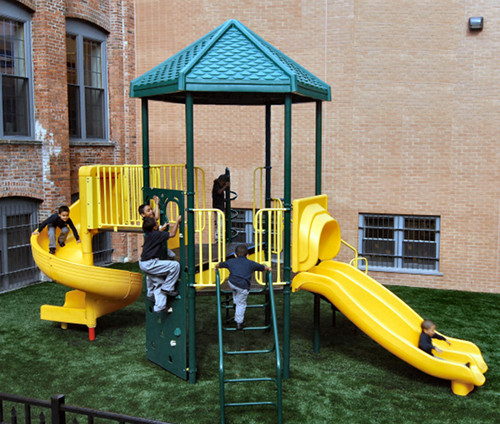
Hire Certified Installers
Unitary surfaces like PIP, turf, and rubber tiles must be installed professionally to meet performance and safety standards. Certified installers ensure proper sub-base prep, thickness, and finishing.
Maintain Safety with Seasonal Upkeep
No matter the surfacing type, regular inspections are key:
- Spring: Top off loose fill, inspect drainage
- Summer: Monitor surface temps and fading
- Fall: Clear leaves and debris
- Winter: Repair cracks, monitor water runoff
Well-maintained surfacing helps preserve safety, accessibility, and appearance.
Accessibility and Inclusion
Every surfacing option offered by Kidstuff Playsystems is ADA-compliant and IPEMA-certified, promoting equal play opportunities for all children. Smooth surfaces like PIP, turf, and tiles are ideal for children using mobility devices, allowing them to move around safely and independently.
For toddlers (ages 6–23 months), we strongly recommend poured-in-place rubber or turf, as these materials provide the best protection against falls while supporting stable movement for crawling and early walking.
Surfaces can also enhance sensory engagement with bright colors, tactile textures, and integrated play zones, creating a more inclusive and inviting play space.
Common Mistakes to Avoid
- Choosing materials based on cost alone
- Forgetting to confirm ADA or IPEMA certification
- Mismatching surfacing to equipment fall heights
- Ignoring climate and drainage concerns
- Overlooking freight and installation logistics
- Delaying replacement when surfacing shows clear signs of wear
Work with the Playground Surfacing Experts
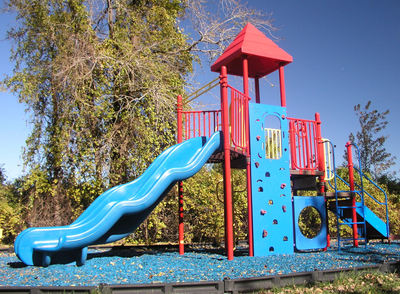
Choosing the right playground safety surfacing impacts every part of your playground—safety, accessibility, maintenance, and budget. At Kidstuff Playsystems, we offer a wide variety of IPEMA-certified and ADA-compliant surfacing options to meet your needs, including engineered wood fiber, rubber mulch, poured-in-place rubber, tiles, and turf.
We’ll help you assess your goals, budget, and location to recommend the safest, most effective solution and connect you with certified installers for seamless setup.
Ready to build a playground that’s safe, inclusive, and built to last?
Call us at (800)255-0153 or request a quote online today. Let’s create a certified, child-safe playground where fun and safety meet—starting from the ground up!

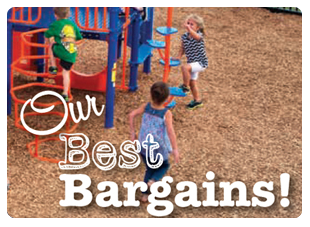
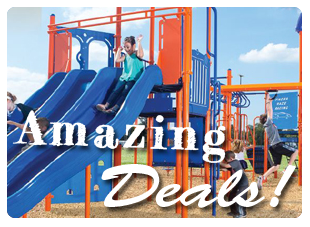
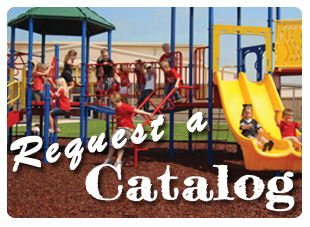
Leave a Reply